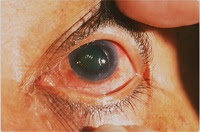What is Glaucoma?

Glaucoma
In this disease the optic nerve gets damaged. The optic nerve is important because it connects the eye to the brain. Vision loss can also occur if it persists for a long time. This damage is usually caused by high pressure inside the 
eye, which is also known as intraocular pressure (IOP). Increased pressure inside the eye can damage the optic nerve, which can lead to loss of vision. The condition is often called the "silent thief
of sight"
because it can cause permanent vision loss without any noticeable
symptoms
until it's too late.
What Causes of Glaucoma?
 |
| Glaucoma Causes |
The
exact cause of glaucoma is not known, but there are several factors
that can increase your risk of developing the disease. These include:
- Age: Often people above the age of 60 are at an increased risk of contracting the disease.
- Genetics: Sometimes people get this disease on the basis of heredity, that is, if the parents have this disease, then it is possible that the child will also get it.
- Medical conditions:
Certain medical conditions such as diabetes, high blood pressure, and
heart disease can increase your risk of developing glaucoma. - Eye injuries: If you have had an eye injury in the past, you are at an increased risk of developing glaucoma.
Symptoms of Glaucoma
In
the early stages, glaucoma may not have any symptoms. As the disease
progresses, however, you may start to notice changes in your vision.
These changes may include:
- Blurred vision
- Loss of peripheral vision
- Halos around lights
- Difficulty adjusting to dark rooms
- Tunnel vision in advanced stages
If you experience any of these symptoms, it is important to see an eye doctor as soon as possible.
Diagnosing Glaucoma
 |
| Diagnosing Glaucoma |
To diagnose glaucoma, your eye doctor will perform a comprehensive eye exam, which may include the following tests:
- Tonometry: This test measures the pressure inside your eye.
- Ophthalmoscopy: This test allows your eye doctor to examine the optic nerve for signs of damage.
- Visual field test: In this test, the doctor measures the patient's peripheral vision.
- Gonioscopy: This test examines the drainage angle between the cornea and iris.
If your eye doctor suspects that you have glaucoma, they may perform additional tests to confirm the diagnosis.
Treating Glaucoma
 |
| Treating Glaucoma |
there is no cure for glaucoma, there are several treatments available
that can help manage the disease and prevent further vision loss. The
most common treatments for glaucoma include:
- Eye drops: Eye drops can be used to lower IOP and prevent further damage to the optic nerve.
- Oral medication: In some cases, oral medication may be used to lower IOP.
- Laser therapy: Laser therapy can be used to open the drainage system inside the eye and lower IOP(intraocular pressure).
- Surgery: If other treatments are not effective, surgery may be necessary to lower IOP(intraocular pressure).
Who Is at Risk of Glaucoma?
What Are the Types of Glaucoma?
(1) Open-angle glaucoma:
(2) Angle-closure glaucoma:
(3) Normal-tension glaucoma:
(4) Congenital glaucoma:
(5) Secondary glaucoma:
Preventing Glaucoma
 |
| Preventing Glaucoma |
Preventing
glaucoma may not always be possible, but there are steps you can take
to lower your risk of developing the disease. In a way, regular eye examination is necessary, because it is also done on the basis of heredity. It can be controlled by adopting regular exercise and balanced diet etc. Protecting your
eyes from UV rays by wearing sunglasses and protecting your eyes from
injury are also important steps to take. While there is no quaranteed
way to prevent glaucoma, taking these steps can help reduce your risk
and keep your eyes healthy.
-min.png)
-min.png)